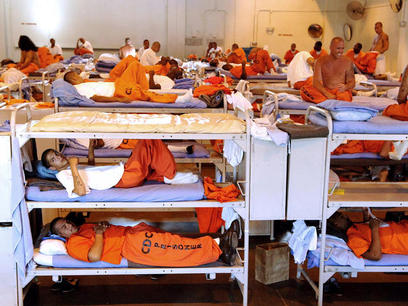Prison Overcrowding Issues

One of many overcrowded prisons in the state of California
- One in Every Thirty One: A 2009 report shows that one in every thirty-one adults in the United States is in prison or on parole or probation.[i]
- 2.3 million people in prison in 2008.[ii]
- California has the nation’s largest and the world’s third largest prison system.[iii]
- The California prison system is severely overcrowded. It was built to house 80,000 inmates but currently holds 165,000.
- There have been 21 prisons and one college/university built in California since 1984.
- Since 1994, the courts have sent over 80,000 second strikers and 7,500 third strikers to state prison.[iv]
- The most highly publicized section is the “third strike” provision. Under this provision an offender who has two prior strikes must, upon conviction for any felony, be sentenced to a minimum term of 25-years-to-life.[v] Thus, while the two prior strikes must be violent or serious felonies, the third strike that triggers the provision can be a non-serious or non-violent felony such as possession of a small amount of drugs or petty theft with a prior felony.
- Less well publicized is the “two strikes” provision, which requires that an offender with one prior strike must receive a doubled sentence upon subsequent conviction for any felony. Thus, while the first strike must be a serious or violent felony, the second strike that triggers this provision can be a non-serious or non-violent felony. Second strike cases are eight times more common than third strike cases.[vi]
- In California, nearly 75 percent of 2nd strikes and 50 percent of 3rd strikes are for nonviolent and non-serious offenses. The most common charges leveled against third-strike criminals are drugs, theft and burglary.
- About 3,700 prisoners in the state are serving life for a third strike that was neither violent nor serious, according to the legal definition. That’s more than 40 percent of the total third-strike population of about 8,500.[vii]
- The 3,700 nonviolent, non-serious three-strikers serving life in California outnumber the 3,263 death-row inmates nationwide.[viii]
Decreased Crime Rates?
- Since implementation of the 3 Strikes Law, crime in San Francisco County has decreased by 30% and in Kern County by 21%. Advocates use this as proof the law decreases crime BUT San Francisco County does not prosecute non-violent and non-serious offenders under the 3 Strikes Law and Kern County prosecutes all possible 3-Strikers vigorously.[ix]
- The Rand Corporation estimates crime would be reduced by 15% if money were spent on treatment programs rather than prisons.
- The Rand Corporation estimates crime would be reduced 3 to 4 times if money were spent on college graduation incentives for high-risk youth rather than prisons.
_________________________________________________________________________________
[i] One in 31: The Long Reach of American Corrections 7 (Pew Center on the States, 2009), available at http:// www.pewcenteronthestates.org/uploadedFiles/PSPP_1in31_report_FINAL_WEB_3-26-09.pdf
[ii]http://www.pewcenteronthestates.org/uploadedFiles/PSPP_1in31_report_FINAL_WEB_3-26-09.pdf
[iii]http://www.prisonlaw.com/pdfs/OvercrowdingArticle.pdf
[iv]http://www.lao.ca.gov/2005/3_strikes/3_strikes_102005.htm#crim justice system
[v] Cal. Penal Code § 667(e)(2)(A)
There are presently over 500 offenses classified as felonies in California.
[vi]http://llr.lls.edu/volumes/v32-issue1/beres.pdf
[vii]http://www.nytimes.com/2010/05/23/magazine/23strikes-t.html
[viii] Id
[ix]http://www.facts1.com/ThreeStrikes/Facts/
